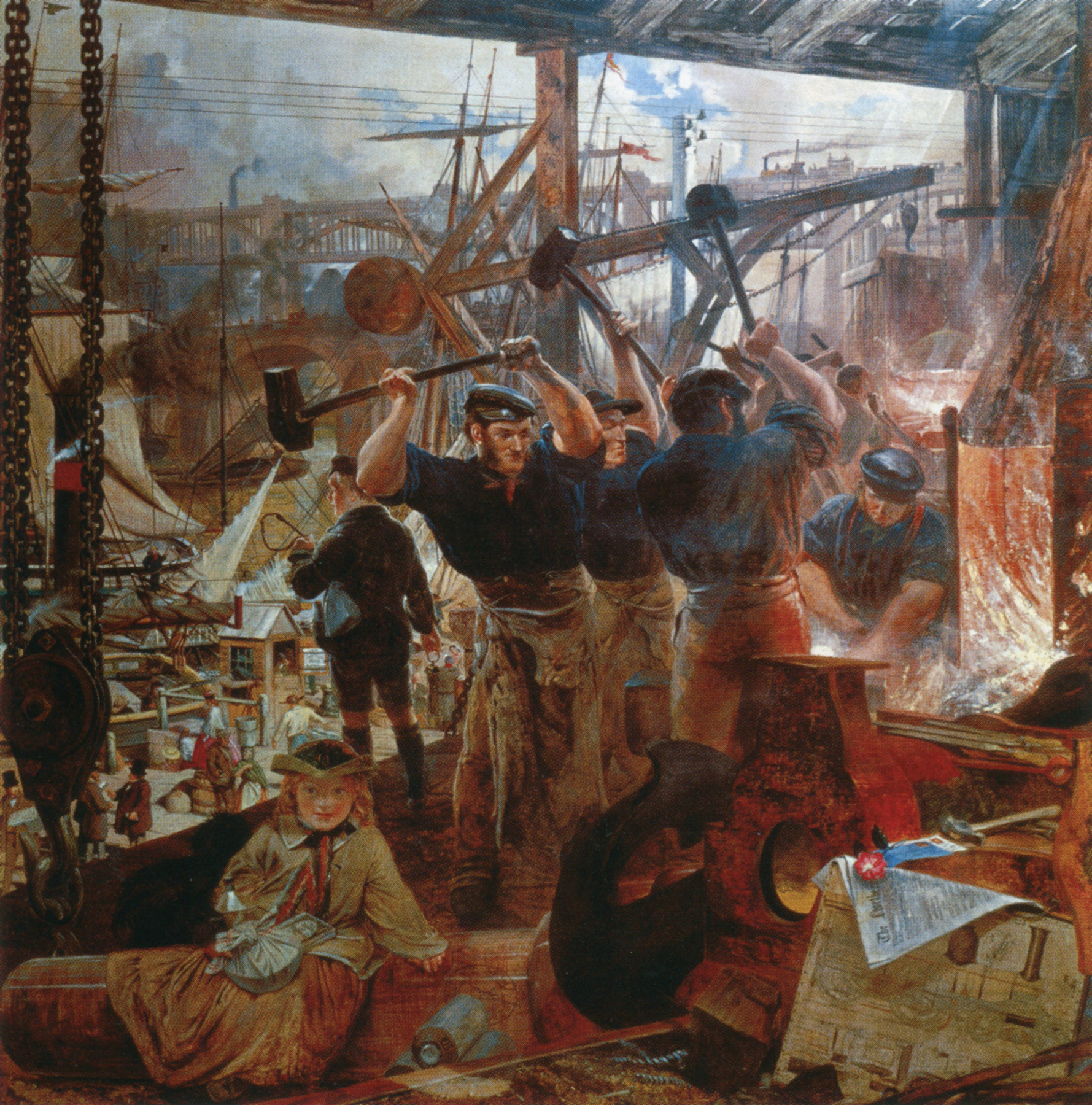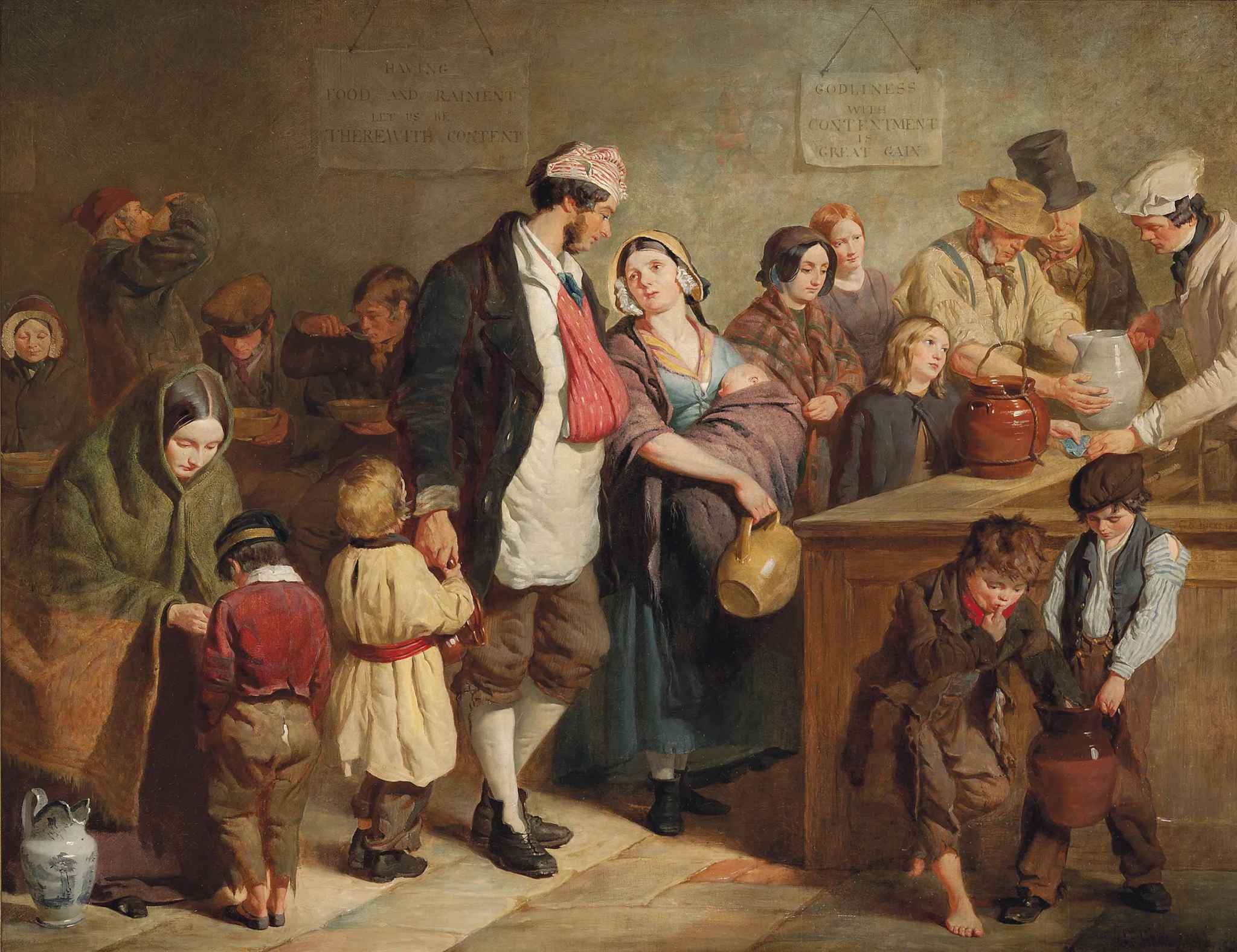1879: Pictorial Sources: Work and Play
The mid to late 19th Century saw a considerable amount of art paying attention to the common folk. Oh yes, there were still plenty of portrait artists preserving the likenesses of the well-to-do, and every other painting from the period seems to be of the military, but the middle and lower classes began to feature extensively. Crowd scenes became popular – artists portraying what was right in front of them – and the audience at public showings recognized themselves in the work, or people like themselves, and representation has always mattered. Let’s have a look at a few works from the period.

First up, William Bell Scott’s Iron and Coal, circa 1860, celebrates those things that made the British Empire possible: metal, sails, bridges, and the staunch labourers that created these things. The central figures, the men with the sledgehammers, pound out the iron that will go into the ships, that will build the great iron bridge that vaults up past the ancient stone one, that will make profit possible for the two portly merchants conferring down on the dock. A girl waits with a lunch, a common sight as the younger children would bring food from home to the family members at their workplaces, doing their part, it being cheaper to send the kids off with a packed lunch than for the workers to go out to the carts in the street or the slap-bangs across the way. No soot or scars mar these stalwart foundrymen, their clothing nearly uniforms and in good repair. While idealised, these figures nevertheless represent an ideal that was getting more respect – that of labor, of the hard work needed to drive the Empire forward.

When things didn’t go so well on the employment front, charity had to be relied upon, as shown in George Elgar Hick’s The Parish Soup Kitchen. Here, the poor who aren’t desperate enough yet to seek the workhouse can get a free meal, although they had to bring their own containers, and in all likelihood, listen to an hour or so of stern moralizing on how being poor was a character failing on their part, delivered by a fat minister who’d never known a day of want in his life. We still haven’t got over that idea. Note the missing laces in the man’s shoes, and the one boy being barefoot, a couple of touches of realism in an otherwise tidied-up version of poverty. These folks are far too well scrubbed and well fed to be received at a soup kitchen. Charities expected people to look desperate, well into the Gilded Age.

Turning toward the boundaries between work and daily life, here’s General Post Office, again by George Elgar Hicks. I think I’ve stood in that line, for the pickup window. These people are a bit more well off, the sort that expect to receive mail, or can afford to send it. And yes, the Royal Mail allowed people to bring their dogs.

If you look far into the back at the right, you can see a few cricket players and a bit of the pitch. The focus here is on the audience. They’ve brought food and drink, and set out to make a day of it. The children are bored already. Leisure time to go watch a cricket match, or play in one, was available to the middle and lower classes by the Gilded Age. Steam power, and the new energy of electricity, and the advent of the cheap train, all brought greater productivity and greater mobility, which combined meant the average person had the coin to skip off to the country for the day of a weekend and the free time to do it in.

One can always rely on William Frith for a massive crowd scene full of Where’s Waldo-style visual jokes. Zoom in on this one and browse through it, there’s a world of GMCs awaiting you. Derby Day brought a mixing of classes, especially in the fields outside of the stands, seen only in the busiest of thoroughfares, and in a festive mood unlike anything short of Guy Fawkes Day. All we need here is a troupe of Morris Dancers. If you look carefully, you might spot a pickpocket.
Something to remember is that the average person stood a pretty good chance of having seen this artwork. Museums and galleries were opening, free of admission, to the general public, under the guidance of wealthy benefactors who needed a charity writeoff and found the guise of improving the minds of the lower classes through exposure to art a handy explanation. People of all walks of life would peruse these artworks, and to what extent art imitated life or the other way round is a question still hotly debated. How much did Frith’s painting influence how people dressed for the next Derby Day, how they acted, what they brought? To what extent do the camera shots of the crowd at a football game influence the fans for the next match? At the very least, the GM has a vast resource to draw upon for describing crowd scenes, or just showing the players a painting and telling them “You’re in the midst of this”.
